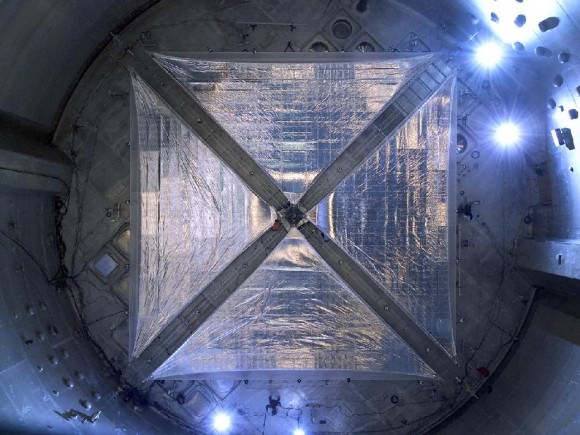[/caption]
Solar sails, much like anti-matter and ion engines appear at first glance to only exist in science fiction. Many technologies from science fiction however, become science fact.
In the example of solar sails, perfecting the technology would allow spacecraft to travel through our solar system using very little fuel.
NASA has been making strides with solar sail technology. Using the NanoSail-D mission, NASA continues to gather valuable data on how well solar sails perform in space. The Planetary Society will also be testing solar sail technology with their LightSail-1 project sometime next year.
How will NASA (and others) test solar sail technology, and develop it into a common, reliable technology?
The second of three recently announced technology demonstrations, The Solar Sail Demonstration, will test the deployment of a solar sail in space along with testing attitude control. The solar sail will also execute a navigation sequence with mission-capable accuracy.
In order to make science fiction into reality, NASA engineers are testing solar sails that could one day provide the propulsion for deep space missions. Spacecraft using solar sails would travel in our solar system in a similar manner to a sailboat through water, except spacecraft using solar sails would rely on sunlight instead of wind. A spacecraft propelled by a solar sail would use the sail to capture photons emitted from the Sun. Over time, the buildup of the solar photons provides enough thrust for a small spacecraft to travel in space.
NASA’s solar sail demonstration mission will deploy and operate a sail area 7 times larger than ever flown in space. The technology used in the demonstration will be applicable to many future space missions, including use in space weather warning systems to provide timely and accurate warnings of solar flare activity. The solar sail demonstration is a collaborative effort between The National Oceanic and Atmospheric Administration (NOAA), NASA and contractor L’Garde Inc.
NASA lists several capabilities solar sails have to offer, such as:
As an example, the GeoStorm project considers locating solar storm warning satellites at pseudo Lagrange points three times further from the Earth by using the solar sail to cancel some solar gravitational pull, thus increasing warning time from ~15 minutes to ~45 minutes.
Providing a satellite with a persistent view of northern or southern latitudes, i.e., a “pole-sitter” project. This allows the observational advantages of today’s geosynchronous satellites for orbits with view angles of the northern and southern high-latitudes.

If you’d like to learn more about solar sails, Caltech has a nice “Solar Sailing 101” page at: http://www.ugcs.caltech.edu/~diedrich/solarsails/intro/intro.html


Now turn that sail into a combination sail/solar panel and they might have something there.
yes that’s a thought. the sail is a mirror so why not a parabolic with a focus?
harness the energy at the focus and convert it to electricity to power an ion engine.
of course this adds to the mass and so on it goes.
yes that’s a thought. the sail is a mirror so why not a parabolic with a focus?
harness the energy at the focus and convert it to electricity to power an ion engine.
of course this adds to the mass and so on it goes.
Been there, done that. The japanese first solar sail last year, IKAROS, successfully used its sail for acceleration, solar cells for power and reflectance liquid crystal panels for attitude control. It has passed Venus and is still being operable according to its web page.
“If successful, IKAROS is to be followed by a 50 m (160 ft) sail, intended to journey to Jupiter and the Trojan asteroids, later in the decade.”
The Earth 3D model in the picture is awesome.
I think it’s a picture of Earth with superimposed solar sail 3D model.
I think it’s a picture of Earth with superimposed solar sail 3D model.
“A spacecraft propelled by a solar sail would use the sail to capture photons emitted from the Sun. Over time, the buildup of the solar photons provides enough thrust for a small spacecraft to travel in space.”
I thought the idea was to reflect the photons and steal their momentum? The above plan sounds half as efficient…
“A spacecraft propelled by a solar sail would use the sail to capture photons emitted from the Sun. Over time, the buildup of the solar photons provides enough thrust for a small spacecraft to travel in space.”
I thought the idea was to reflect the photons and steal their momentum? The above plan sounds half as efficient…
Deorbiting satellites would be a cool way to use it. Just tag the satellite and deploy the sail.